Australia's Economic Performance (2005-2014): A Macroeconomic Analysis
VerifiedAdded on 2023/06/09
|15
|3138
|420
Report
AI Summary
This report assesses Australia's economic performance from 2005 to 2014, utilizing macroeconomic indicators like real GDP, GDP growth rate, per capita GDP, unemployment, and inflation. The analysis reveals that Australia maintained a strong economic position, even during the 2008 financial crisis, largely due to proactive fiscal and monetary policies. Despite its reliance on international trade, Australia avoided recession, making it unique among OECD countries. The report highlights government interventions, such as interest rate adjustments and exchange rate management, which supported economic stability. The study concludes with a positive outlook for Australia's economic future, based on its past resilience and effective policy implementation. The report also touches upon the types of unemployement, the price levels and causes of inflation in Australia.
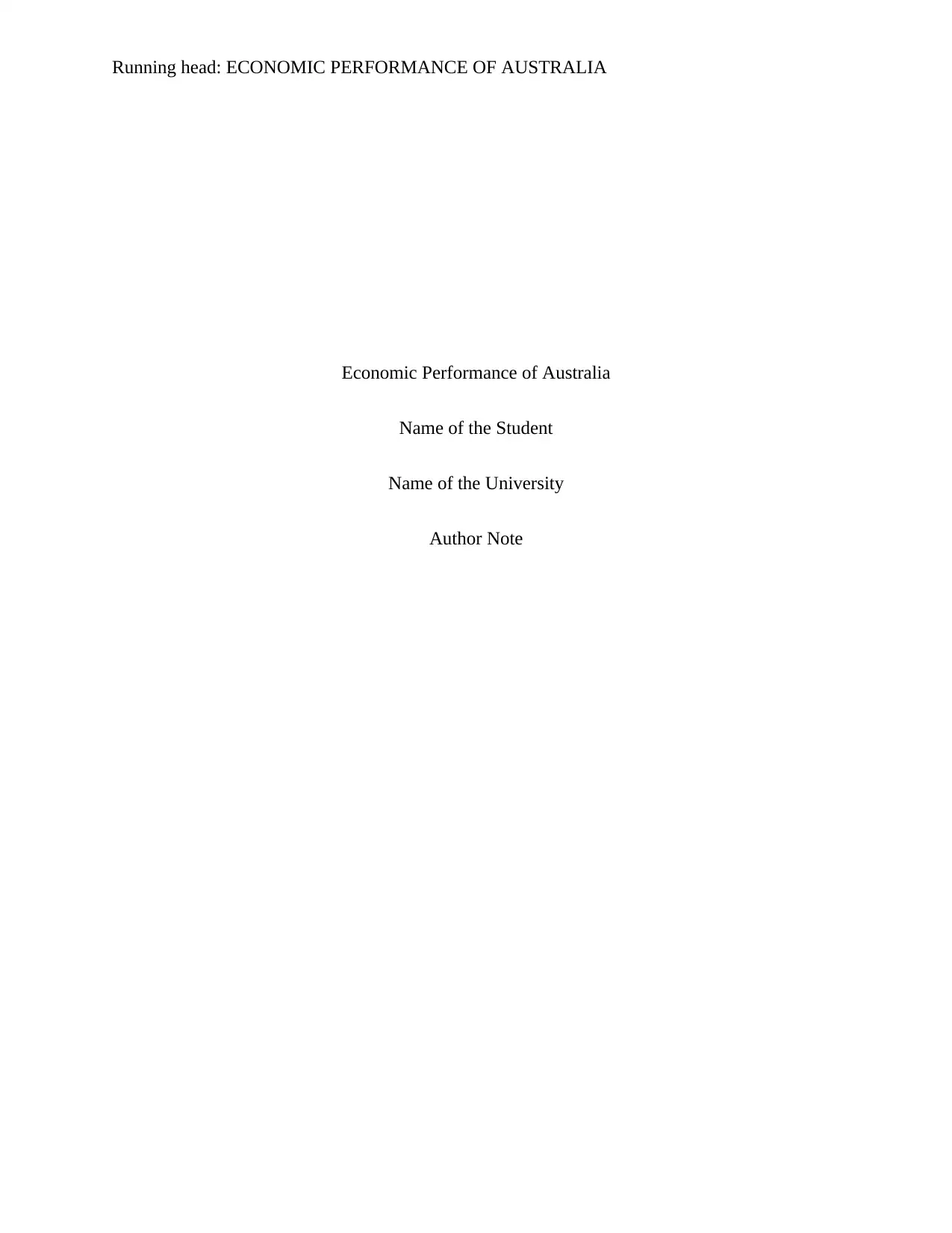
Running head: ECONOMIC PERFORMANCE OF AUSTRALIA
Economic Performance of Australia
Name of the Student
Name of the University
Author Note
Economic Performance of Australia
Name of the Student
Name of the University
Author Note
Paraphrase This Document
Need a fresh take? Get an instant paraphrase of this document with our AI Paraphraser
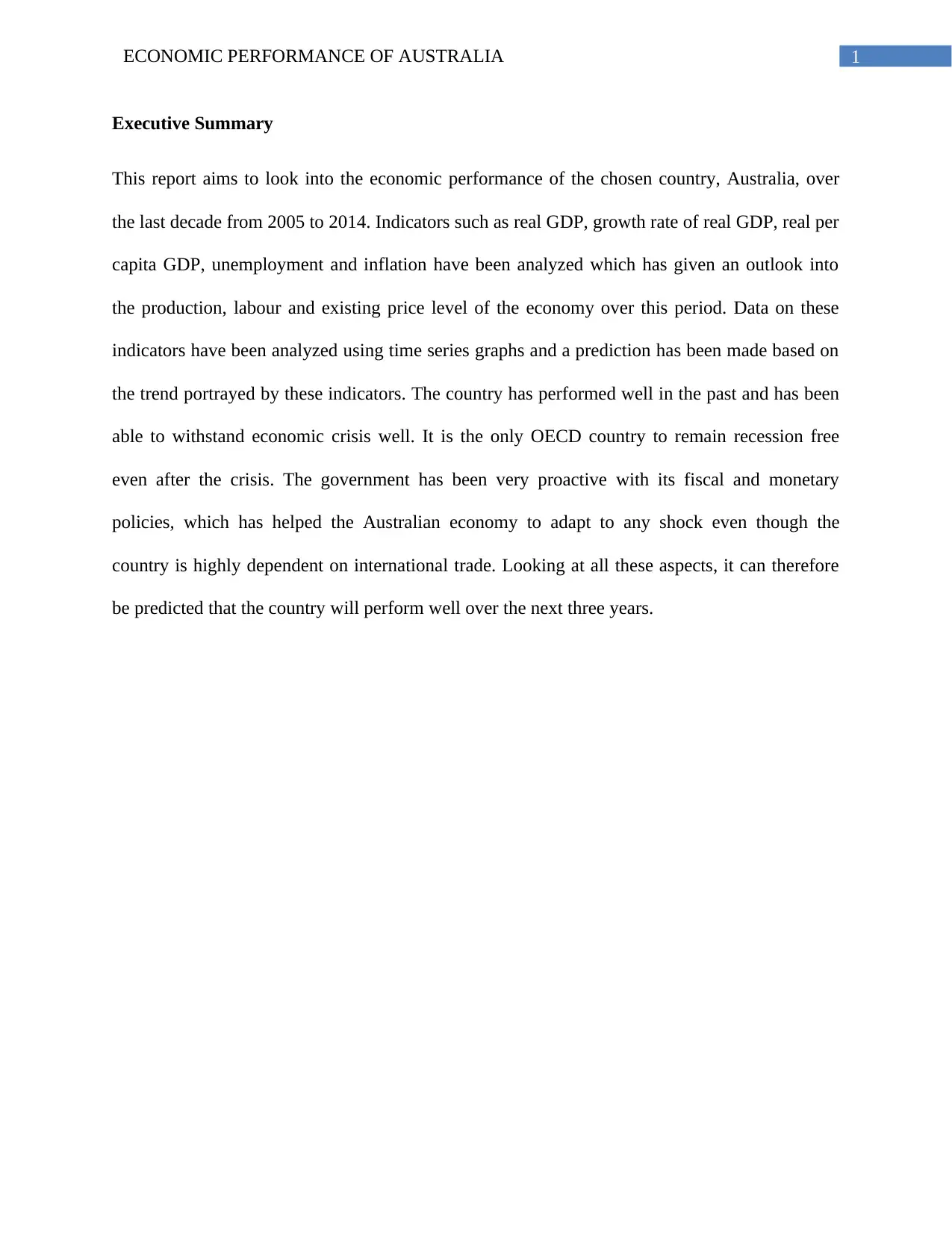
1ECONOMIC PERFORMANCE OF AUSTRALIA
Executive Summary
This report aims to look into the economic performance of the chosen country, Australia, over
the last decade from 2005 to 2014. Indicators such as real GDP, growth rate of real GDP, real per
capita GDP, unemployment and inflation have been analyzed which has given an outlook into
the production, labour and existing price level of the economy over this period. Data on these
indicators have been analyzed using time series graphs and a prediction has been made based on
the trend portrayed by these indicators. The country has performed well in the past and has been
able to withstand economic crisis well. It is the only OECD country to remain recession free
even after the crisis. The government has been very proactive with its fiscal and monetary
policies, which has helped the Australian economy to adapt to any shock even though the
country is highly dependent on international trade. Looking at all these aspects, it can therefore
be predicted that the country will perform well over the next three years.
Executive Summary
This report aims to look into the economic performance of the chosen country, Australia, over
the last decade from 2005 to 2014. Indicators such as real GDP, growth rate of real GDP, real per
capita GDP, unemployment and inflation have been analyzed which has given an outlook into
the production, labour and existing price level of the economy over this period. Data on these
indicators have been analyzed using time series graphs and a prediction has been made based on
the trend portrayed by these indicators. The country has performed well in the past and has been
able to withstand economic crisis well. It is the only OECD country to remain recession free
even after the crisis. The government has been very proactive with its fiscal and monetary
policies, which has helped the Australian economy to adapt to any shock even though the
country is highly dependent on international trade. Looking at all these aspects, it can therefore
be predicted that the country will perform well over the next three years.
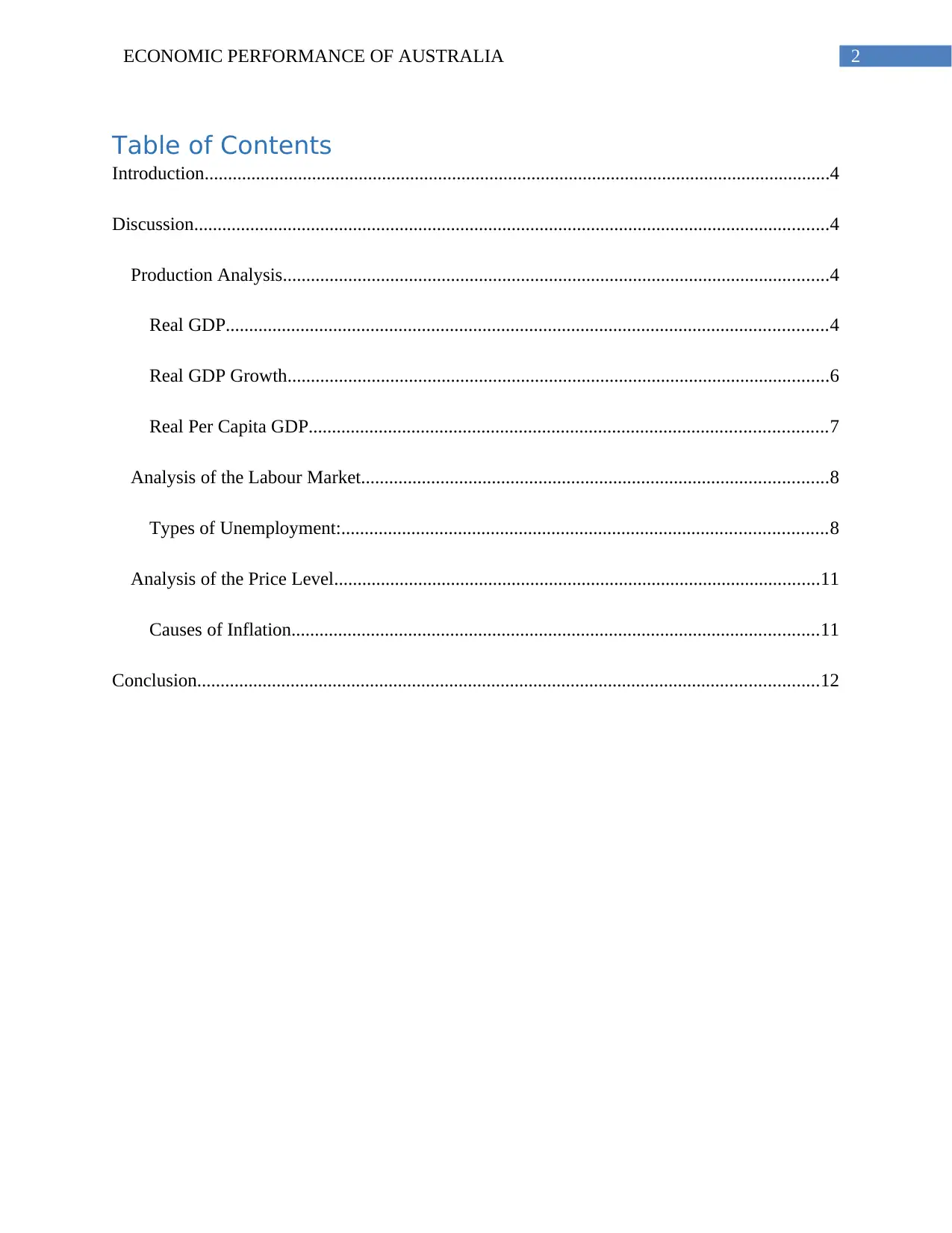
2ECONOMIC PERFORMANCE OF AUSTRALIA
Table of Contents
Introduction......................................................................................................................................4
Discussion........................................................................................................................................4
Production Analysis.....................................................................................................................4
Real GDP.................................................................................................................................4
Real GDP Growth....................................................................................................................6
Real Per Capita GDP...............................................................................................................7
Analysis of the Labour Market....................................................................................................8
Types of Unemployment:........................................................................................................8
Analysis of the Price Level........................................................................................................11
Causes of Inflation.................................................................................................................11
Conclusion.....................................................................................................................................12
Table of Contents
Introduction......................................................................................................................................4
Discussion........................................................................................................................................4
Production Analysis.....................................................................................................................4
Real GDP.................................................................................................................................4
Real GDP Growth....................................................................................................................6
Real Per Capita GDP...............................................................................................................7
Analysis of the Labour Market....................................................................................................8
Types of Unemployment:........................................................................................................8
Analysis of the Price Level........................................................................................................11
Causes of Inflation.................................................................................................................11
Conclusion.....................................................................................................................................12
⊘ This is a preview!⊘
Do you want full access?
Subscribe today to unlock all pages.

Trusted by 1+ million students worldwide
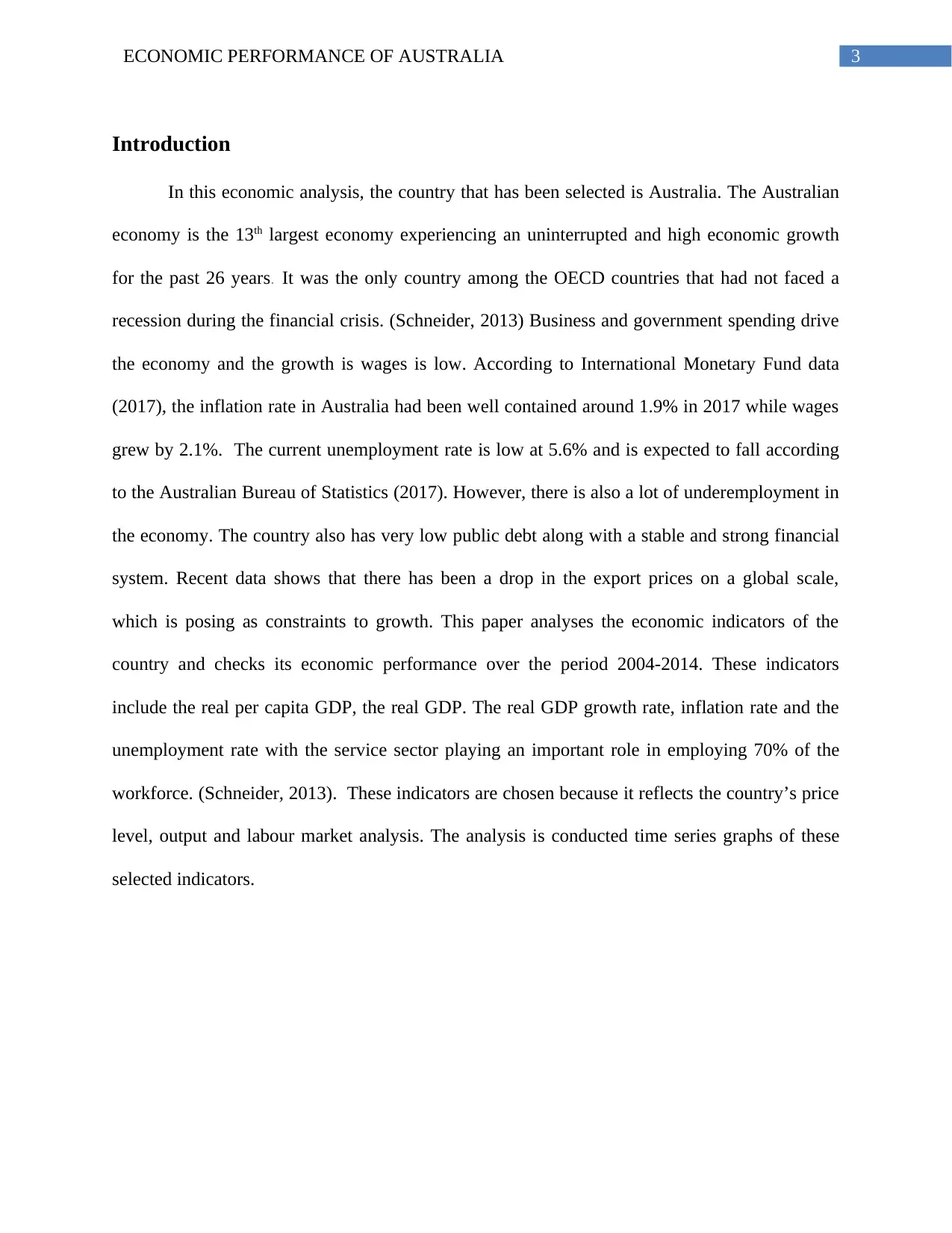
3ECONOMIC PERFORMANCE OF AUSTRALIA
Introduction
In this economic analysis, the country that has been selected is Australia. The Australian
economy is the 13th largest economy experiencing an uninterrupted and high economic growth
for the past 26 years. It was the only country among the OECD countries that had not faced a
recession during the financial crisis. (Schneider, 2013) Business and government spending drive
the economy and the growth is wages is low. According to International Monetary Fund data
(2017), the inflation rate in Australia had been well contained around 1.9% in 2017 while wages
grew by 2.1%. The current unemployment rate is low at 5.6% and is expected to fall according
to the Australian Bureau of Statistics (2017). However, there is also a lot of underemployment in
the economy. The country also has very low public debt along with a stable and strong financial
system. Recent data shows that there has been a drop in the export prices on a global scale,
which is posing as constraints to growth. This paper analyses the economic indicators of the
country and checks its economic performance over the period 2004-2014. These indicators
include the real per capita GDP, the real GDP. The real GDP growth rate, inflation rate and the
unemployment rate with the service sector playing an important role in employing 70% of the
workforce. (Schneider, 2013). These indicators are chosen because it reflects the country’s price
level, output and labour market analysis. The analysis is conducted time series graphs of these
selected indicators.
Introduction
In this economic analysis, the country that has been selected is Australia. The Australian
economy is the 13th largest economy experiencing an uninterrupted and high economic growth
for the past 26 years. It was the only country among the OECD countries that had not faced a
recession during the financial crisis. (Schneider, 2013) Business and government spending drive
the economy and the growth is wages is low. According to International Monetary Fund data
(2017), the inflation rate in Australia had been well contained around 1.9% in 2017 while wages
grew by 2.1%. The current unemployment rate is low at 5.6% and is expected to fall according
to the Australian Bureau of Statistics (2017). However, there is also a lot of underemployment in
the economy. The country also has very low public debt along with a stable and strong financial
system. Recent data shows that there has been a drop in the export prices on a global scale,
which is posing as constraints to growth. This paper analyses the economic indicators of the
country and checks its economic performance over the period 2004-2014. These indicators
include the real per capita GDP, the real GDP. The real GDP growth rate, inflation rate and the
unemployment rate with the service sector playing an important role in employing 70% of the
workforce. (Schneider, 2013). These indicators are chosen because it reflects the country’s price
level, output and labour market analysis. The analysis is conducted time series graphs of these
selected indicators.
Paraphrase This Document
Need a fresh take? Get an instant paraphrase of this document with our AI Paraphraser

4ECONOMIC PERFORMANCE OF AUSTRALIA
Discussion
Production Analysis
Real GDP
Real gross domestic product or real GDP is a measure of the final value of the goods and
services than an economy produces within its geographical border in a given year. This measure
is inflation-adjusted and is expressed in terms of a base year, which allows it to account for
changes in the price level and thus provide a more accurate reflection of the economic growth of
the country. Governments to analyze the purchasing power of the economy along with growth
often use this measure. The time series graph shows that the real GDP has been increasing over
the last decade in Australia. Even during the financial crisis in 2008, the economy did not face a
fall in its output. The terms of trade had improved for Australia since the 2000s and this lead to a
continuous rise in real GDP mostly above the forecasted level. However, in 2012 mining
investments declined as a response to low commodity prices, which was reflected by the fall in
the real GDP but non-mining investment caught up and with that, GDP started rising again.
(Steven, 2016). The government supported this by lowering the interest rates along with
depreciation of exchange rates.
Discussion
Production Analysis
Real GDP
Real gross domestic product or real GDP is a measure of the final value of the goods and
services than an economy produces within its geographical border in a given year. This measure
is inflation-adjusted and is expressed in terms of a base year, which allows it to account for
changes in the price level and thus provide a more accurate reflection of the economic growth of
the country. Governments to analyze the purchasing power of the economy along with growth
often use this measure. The time series graph shows that the real GDP has been increasing over
the last decade in Australia. Even during the financial crisis in 2008, the economy did not face a
fall in its output. The terms of trade had improved for Australia since the 2000s and this lead to a
continuous rise in real GDP mostly above the forecasted level. However, in 2012 mining
investments declined as a response to low commodity prices, which was reflected by the fall in
the real GDP but non-mining investment caught up and with that, GDP started rising again.
(Steven, 2016). The government supported this by lowering the interest rates along with
depreciation of exchange rates.
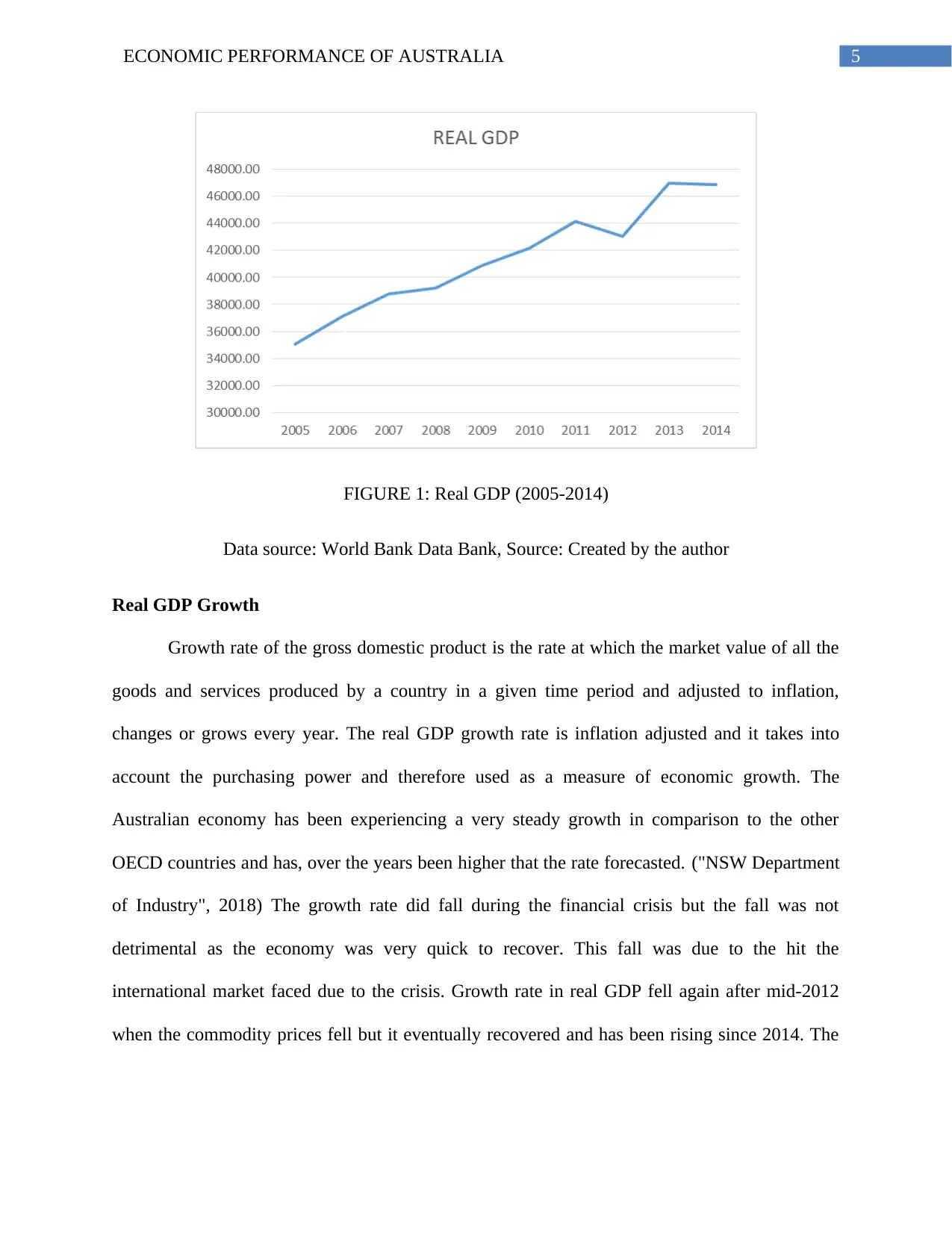
5ECONOMIC PERFORMANCE OF AUSTRALIA
FIGURE 1: Real GDP (2005-2014)
Data source: World Bank Data Bank, Source: Created by the author
Real GDP Growth
Growth rate of the gross domestic product is the rate at which the market value of all the
goods and services produced by a country in a given time period and adjusted to inflation,
changes or grows every year. The real GDP growth rate is inflation adjusted and it takes into
account the purchasing power and therefore used as a measure of economic growth. The
Australian economy has been experiencing a very steady growth in comparison to the other
OECD countries and has, over the years been higher that the rate forecasted. ("NSW Department
of Industry", 2018) The growth rate did fall during the financial crisis but the fall was not
detrimental as the economy was very quick to recover. This fall was due to the hit the
international market faced due to the crisis. Growth rate in real GDP fell again after mid-2012
when the commodity prices fell but it eventually recovered and has been rising since 2014. The
FIGURE 1: Real GDP (2005-2014)
Data source: World Bank Data Bank, Source: Created by the author
Real GDP Growth
Growth rate of the gross domestic product is the rate at which the market value of all the
goods and services produced by a country in a given time period and adjusted to inflation,
changes or grows every year. The real GDP growth rate is inflation adjusted and it takes into
account the purchasing power and therefore used as a measure of economic growth. The
Australian economy has been experiencing a very steady growth in comparison to the other
OECD countries and has, over the years been higher that the rate forecasted. ("NSW Department
of Industry", 2018) The growth rate did fall during the financial crisis but the fall was not
detrimental as the economy was very quick to recover. This fall was due to the hit the
international market faced due to the crisis. Growth rate in real GDP fell again after mid-2012
when the commodity prices fell but it eventually recovered and has been rising since 2014. The
⊘ This is a preview!⊘
Do you want full access?
Subscribe today to unlock all pages.

Trusted by 1+ million students worldwide
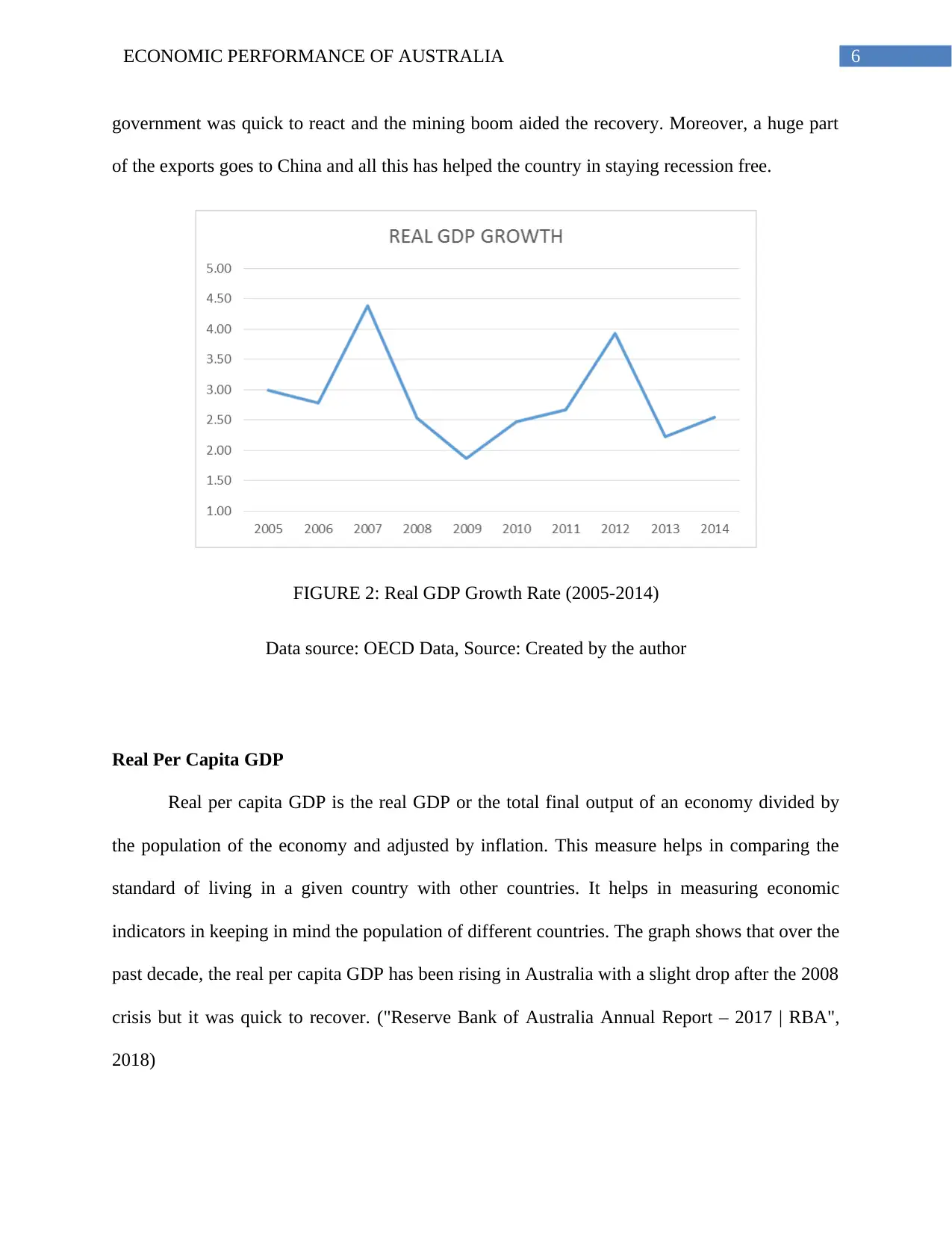
6ECONOMIC PERFORMANCE OF AUSTRALIA
government was quick to react and the mining boom aided the recovery. Moreover, a huge part
of the exports goes to China and all this has helped the country in staying recession free.
FIGURE 2: Real GDP Growth Rate (2005-2014)
Data source: OECD Data, Source: Created by the author
Real Per Capita GDP
Real per capita GDP is the real GDP or the total final output of an economy divided by
the population of the economy and adjusted by inflation. This measure helps in comparing the
standard of living in a given country with other countries. It helps in measuring economic
indicators in keeping in mind the population of different countries. The graph shows that over the
past decade, the real per capita GDP has been rising in Australia with a slight drop after the 2008
crisis but it was quick to recover. ("Reserve Bank of Australia Annual Report – 2017 | RBA",
2018)
government was quick to react and the mining boom aided the recovery. Moreover, a huge part
of the exports goes to China and all this has helped the country in staying recession free.
FIGURE 2: Real GDP Growth Rate (2005-2014)
Data source: OECD Data, Source: Created by the author
Real Per Capita GDP
Real per capita GDP is the real GDP or the total final output of an economy divided by
the population of the economy and adjusted by inflation. This measure helps in comparing the
standard of living in a given country with other countries. It helps in measuring economic
indicators in keeping in mind the population of different countries. The graph shows that over the
past decade, the real per capita GDP has been rising in Australia with a slight drop after the 2008
crisis but it was quick to recover. ("Reserve Bank of Australia Annual Report – 2017 | RBA",
2018)
Paraphrase This Document
Need a fresh take? Get an instant paraphrase of this document with our AI Paraphraser
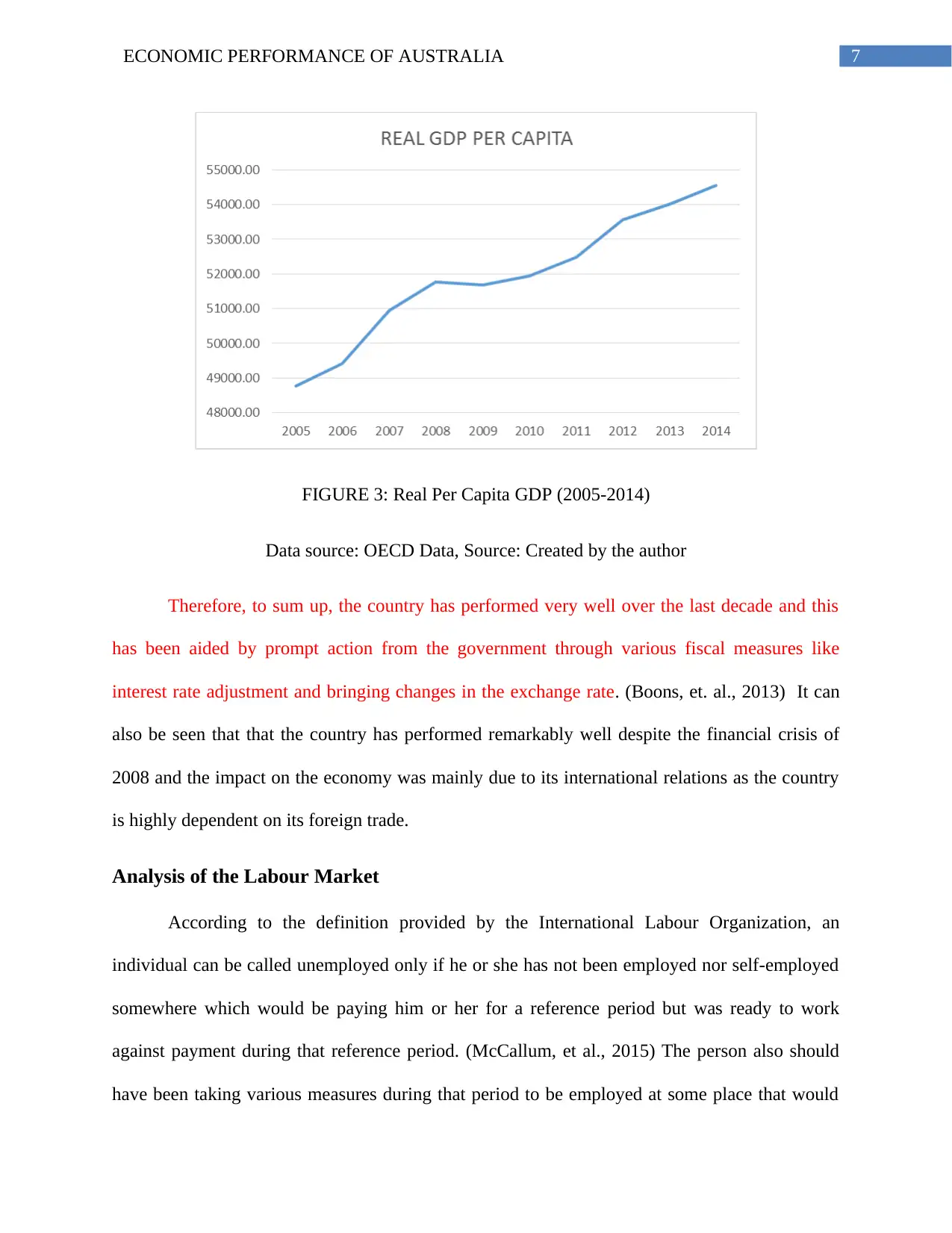
7ECONOMIC PERFORMANCE OF AUSTRALIA
FIGURE 3: Real Per Capita GDP (2005-2014)
Data source: OECD Data, Source: Created by the author
Therefore, to sum up, the country has performed very well over the last decade and this
has been aided by prompt action from the government through various fiscal measures like
interest rate adjustment and bringing changes in the exchange rate. (Boons, et. al., 2013) It can
also be seen that that the country has performed remarkably well despite the financial crisis of
2008 and the impact on the economy was mainly due to its international relations as the country
is highly dependent on its foreign trade.
Analysis of the Labour Market
According to the definition provided by the International Labour Organization, an
individual can be called unemployed only if he or she has not been employed nor self-employed
somewhere which would be paying him or her for a reference period but was ready to work
against payment during that reference period. (McCallum, et al., 2015) The person also should
have been taking various measures during that period to be employed at some place that would
FIGURE 3: Real Per Capita GDP (2005-2014)
Data source: OECD Data, Source: Created by the author
Therefore, to sum up, the country has performed very well over the last decade and this
has been aided by prompt action from the government through various fiscal measures like
interest rate adjustment and bringing changes in the exchange rate. (Boons, et. al., 2013) It can
also be seen that that the country has performed remarkably well despite the financial crisis of
2008 and the impact on the economy was mainly due to its international relations as the country
is highly dependent on its foreign trade.
Analysis of the Labour Market
According to the definition provided by the International Labour Organization, an
individual can be called unemployed only if he or she has not been employed nor self-employed
somewhere which would be paying him or her for a reference period but was ready to work
against payment during that reference period. (McCallum, et al., 2015) The person also should
have been taking various measures during that period to be employed at some place that would
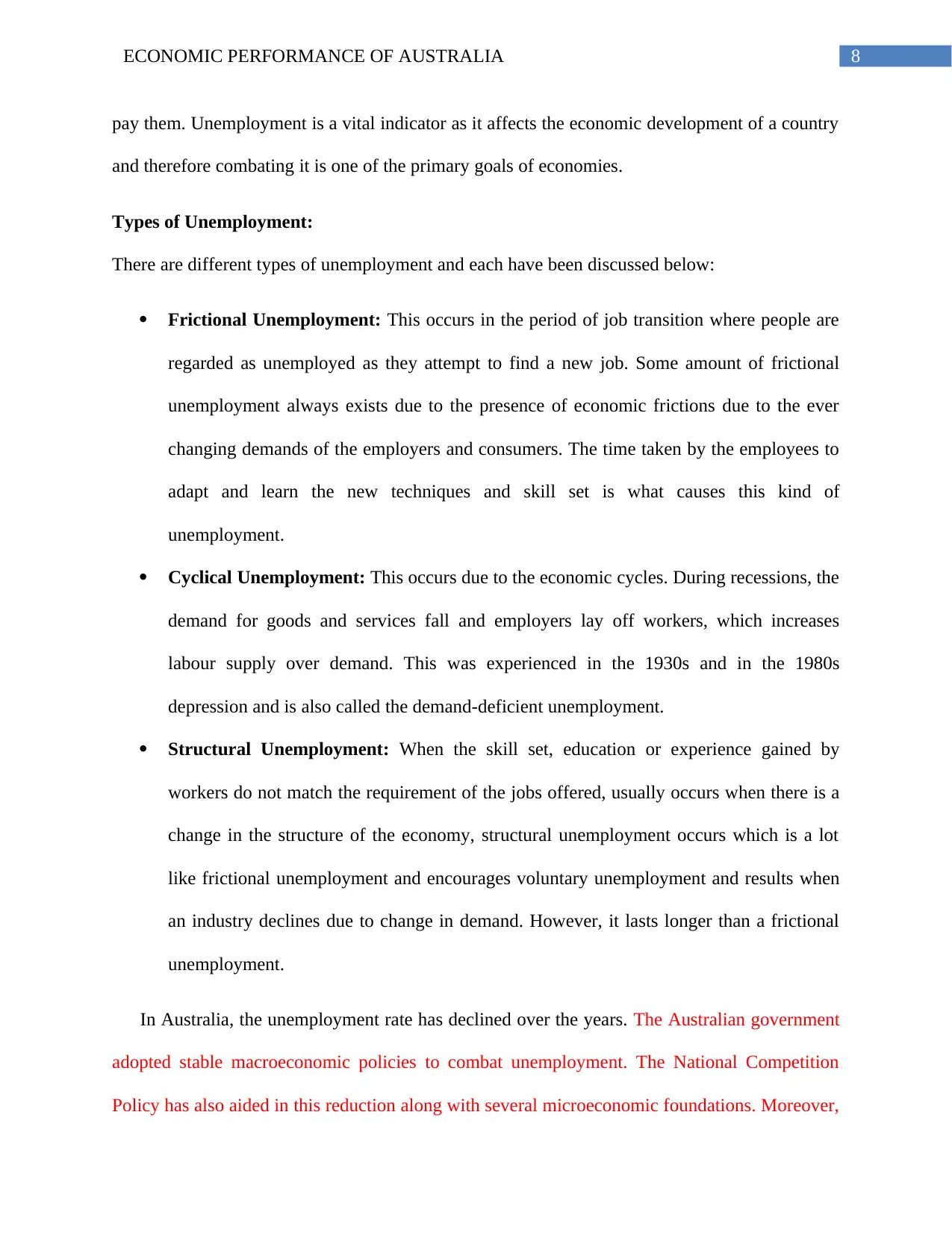
8ECONOMIC PERFORMANCE OF AUSTRALIA
pay them. Unemployment is a vital indicator as it affects the economic development of a country
and therefore combating it is one of the primary goals of economies.
Types of Unemployment:
There are different types of unemployment and each have been discussed below:
Frictional Unemployment: This occurs in the period of job transition where people are
regarded as unemployed as they attempt to find a new job. Some amount of frictional
unemployment always exists due to the presence of economic frictions due to the ever
changing demands of the employers and consumers. The time taken by the employees to
adapt and learn the new techniques and skill set is what causes this kind of
unemployment.
Cyclical Unemployment: This occurs due to the economic cycles. During recessions, the
demand for goods and services fall and employers lay off workers, which increases
labour supply over demand. This was experienced in the 1930s and in the 1980s
depression and is also called the demand-deficient unemployment.
Structural Unemployment: When the skill set, education or experience gained by
workers do not match the requirement of the jobs offered, usually occurs when there is a
change in the structure of the economy, structural unemployment occurs which is a lot
like frictional unemployment and encourages voluntary unemployment and results when
an industry declines due to change in demand. However, it lasts longer than a frictional
unemployment.
In Australia, the unemployment rate has declined over the years. The Australian government
adopted stable macroeconomic policies to combat unemployment. The National Competition
Policy has also aided in this reduction along with several microeconomic foundations. Moreover,
pay them. Unemployment is a vital indicator as it affects the economic development of a country
and therefore combating it is one of the primary goals of economies.
Types of Unemployment:
There are different types of unemployment and each have been discussed below:
Frictional Unemployment: This occurs in the period of job transition where people are
regarded as unemployed as they attempt to find a new job. Some amount of frictional
unemployment always exists due to the presence of economic frictions due to the ever
changing demands of the employers and consumers. The time taken by the employees to
adapt and learn the new techniques and skill set is what causes this kind of
unemployment.
Cyclical Unemployment: This occurs due to the economic cycles. During recessions, the
demand for goods and services fall and employers lay off workers, which increases
labour supply over demand. This was experienced in the 1930s and in the 1980s
depression and is also called the demand-deficient unemployment.
Structural Unemployment: When the skill set, education or experience gained by
workers do not match the requirement of the jobs offered, usually occurs when there is a
change in the structure of the economy, structural unemployment occurs which is a lot
like frictional unemployment and encourages voluntary unemployment and results when
an industry declines due to change in demand. However, it lasts longer than a frictional
unemployment.
In Australia, the unemployment rate has declined over the years. The Australian government
adopted stable macroeconomic policies to combat unemployment. The National Competition
Policy has also aided in this reduction along with several microeconomic foundations. Moreover,
⊘ This is a preview!⊘
Do you want full access?
Subscribe today to unlock all pages.

Trusted by 1+ million students worldwide
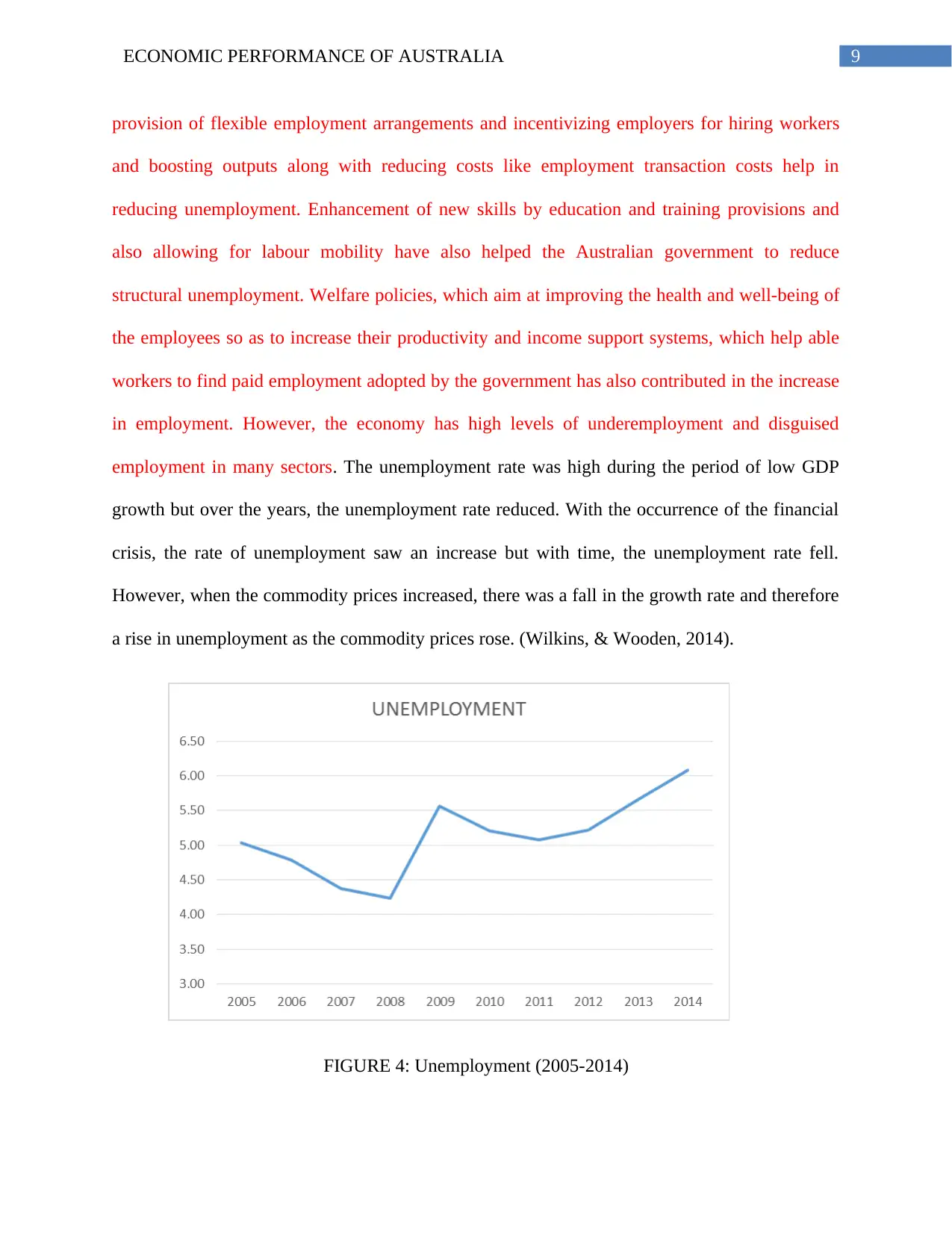
9ECONOMIC PERFORMANCE OF AUSTRALIA
provision of flexible employment arrangements and incentivizing employers for hiring workers
and boosting outputs along with reducing costs like employment transaction costs help in
reducing unemployment. Enhancement of new skills by education and training provisions and
also allowing for labour mobility have also helped the Australian government to reduce
structural unemployment. Welfare policies, which aim at improving the health and well-being of
the employees so as to increase their productivity and income support systems, which help able
workers to find paid employment adopted by the government has also contributed in the increase
in employment. However, the economy has high levels of underemployment and disguised
employment in many sectors. The unemployment rate was high during the period of low GDP
growth but over the years, the unemployment rate reduced. With the occurrence of the financial
crisis, the rate of unemployment saw an increase but with time, the unemployment rate fell.
However, when the commodity prices increased, there was a fall in the growth rate and therefore
a rise in unemployment as the commodity prices rose. (Wilkins, & Wooden, 2014).
FIGURE 4: Unemployment (2005-2014)
provision of flexible employment arrangements and incentivizing employers for hiring workers
and boosting outputs along with reducing costs like employment transaction costs help in
reducing unemployment. Enhancement of new skills by education and training provisions and
also allowing for labour mobility have also helped the Australian government to reduce
structural unemployment. Welfare policies, which aim at improving the health and well-being of
the employees so as to increase their productivity and income support systems, which help able
workers to find paid employment adopted by the government has also contributed in the increase
in employment. However, the economy has high levels of underemployment and disguised
employment in many sectors. The unemployment rate was high during the period of low GDP
growth but over the years, the unemployment rate reduced. With the occurrence of the financial
crisis, the rate of unemployment saw an increase but with time, the unemployment rate fell.
However, when the commodity prices increased, there was a fall in the growth rate and therefore
a rise in unemployment as the commodity prices rose. (Wilkins, & Wooden, 2014).
FIGURE 4: Unemployment (2005-2014)
Paraphrase This Document
Need a fresh take? Get an instant paraphrase of this document with our AI Paraphraser
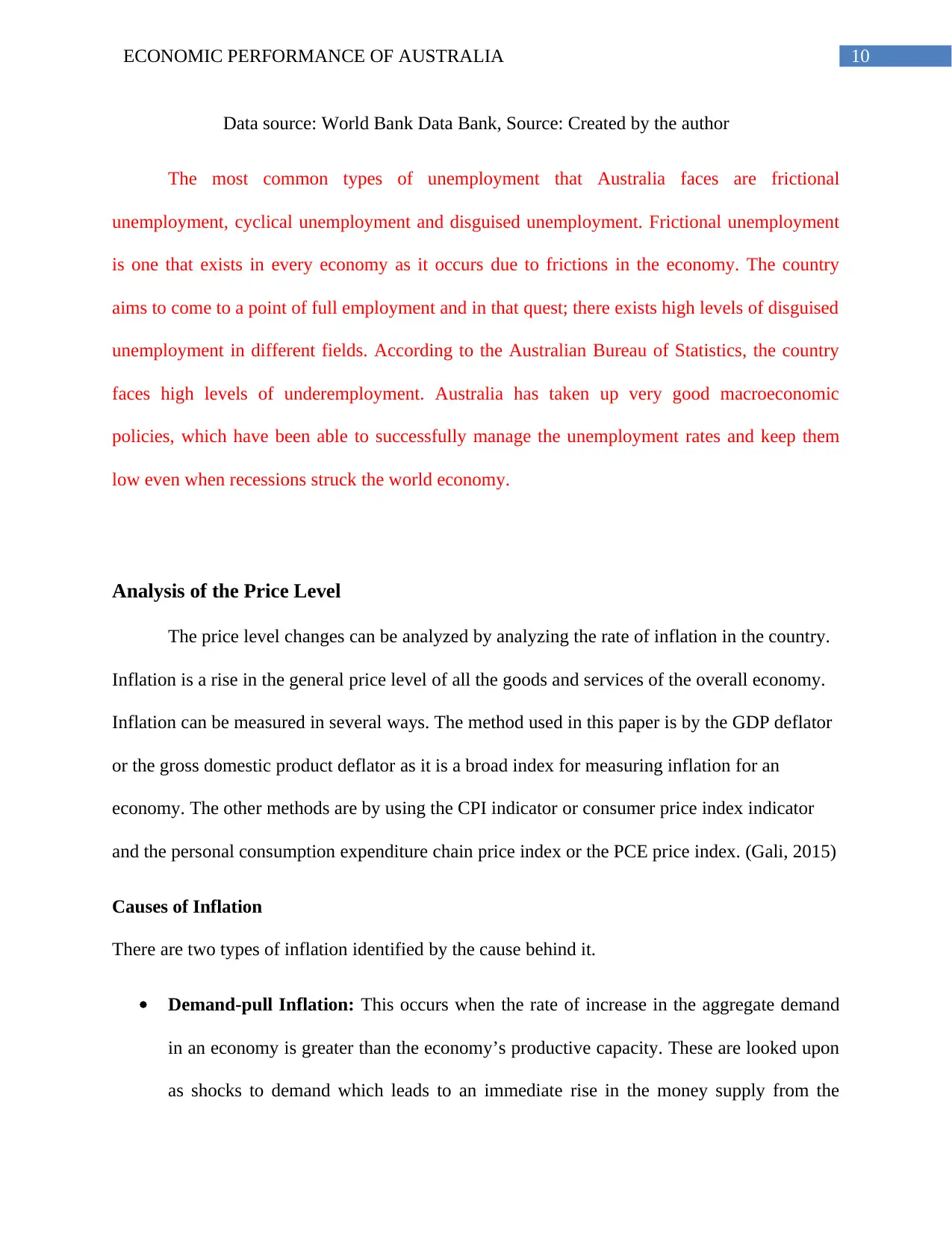
10ECONOMIC PERFORMANCE OF AUSTRALIA
Data source: World Bank Data Bank, Source: Created by the author
The most common types of unemployment that Australia faces are frictional
unemployment, cyclical unemployment and disguised unemployment. Frictional unemployment
is one that exists in every economy as it occurs due to frictions in the economy. The country
aims to come to a point of full employment and in that quest; there exists high levels of disguised
unemployment in different fields. According to the Australian Bureau of Statistics, the country
faces high levels of underemployment. Australia has taken up very good macroeconomic
policies, which have been able to successfully manage the unemployment rates and keep them
low even when recessions struck the world economy.
Analysis of the Price Level
The price level changes can be analyzed by analyzing the rate of inflation in the country.
Inflation is a rise in the general price level of all the goods and services of the overall economy.
Inflation can be measured in several ways. The method used in this paper is by the GDP deflator
or the gross domestic product deflator as it is a broad index for measuring inflation for an
economy. The other methods are by using the CPI indicator or consumer price index indicator
and the personal consumption expenditure chain price index or the PCE price index. (Gali, 2015)
Causes of Inflation
There are two types of inflation identified by the cause behind it.
Demand-pull Inflation: This occurs when the rate of increase in the aggregate demand
in an economy is greater than the economy’s productive capacity. These are looked upon
as shocks to demand which leads to an immediate rise in the money supply from the
Data source: World Bank Data Bank, Source: Created by the author
The most common types of unemployment that Australia faces are frictional
unemployment, cyclical unemployment and disguised unemployment. Frictional unemployment
is one that exists in every economy as it occurs due to frictions in the economy. The country
aims to come to a point of full employment and in that quest; there exists high levels of disguised
unemployment in different fields. According to the Australian Bureau of Statistics, the country
faces high levels of underemployment. Australia has taken up very good macroeconomic
policies, which have been able to successfully manage the unemployment rates and keep them
low even when recessions struck the world economy.
Analysis of the Price Level
The price level changes can be analyzed by analyzing the rate of inflation in the country.
Inflation is a rise in the general price level of all the goods and services of the overall economy.
Inflation can be measured in several ways. The method used in this paper is by the GDP deflator
or the gross domestic product deflator as it is a broad index for measuring inflation for an
economy. The other methods are by using the CPI indicator or consumer price index indicator
and the personal consumption expenditure chain price index or the PCE price index. (Gali, 2015)
Causes of Inflation
There are two types of inflation identified by the cause behind it.
Demand-pull Inflation: This occurs when the rate of increase in the aggregate demand
in an economy is greater than the economy’s productive capacity. These are looked upon
as shocks to demand which leads to an immediate rise in the money supply from the
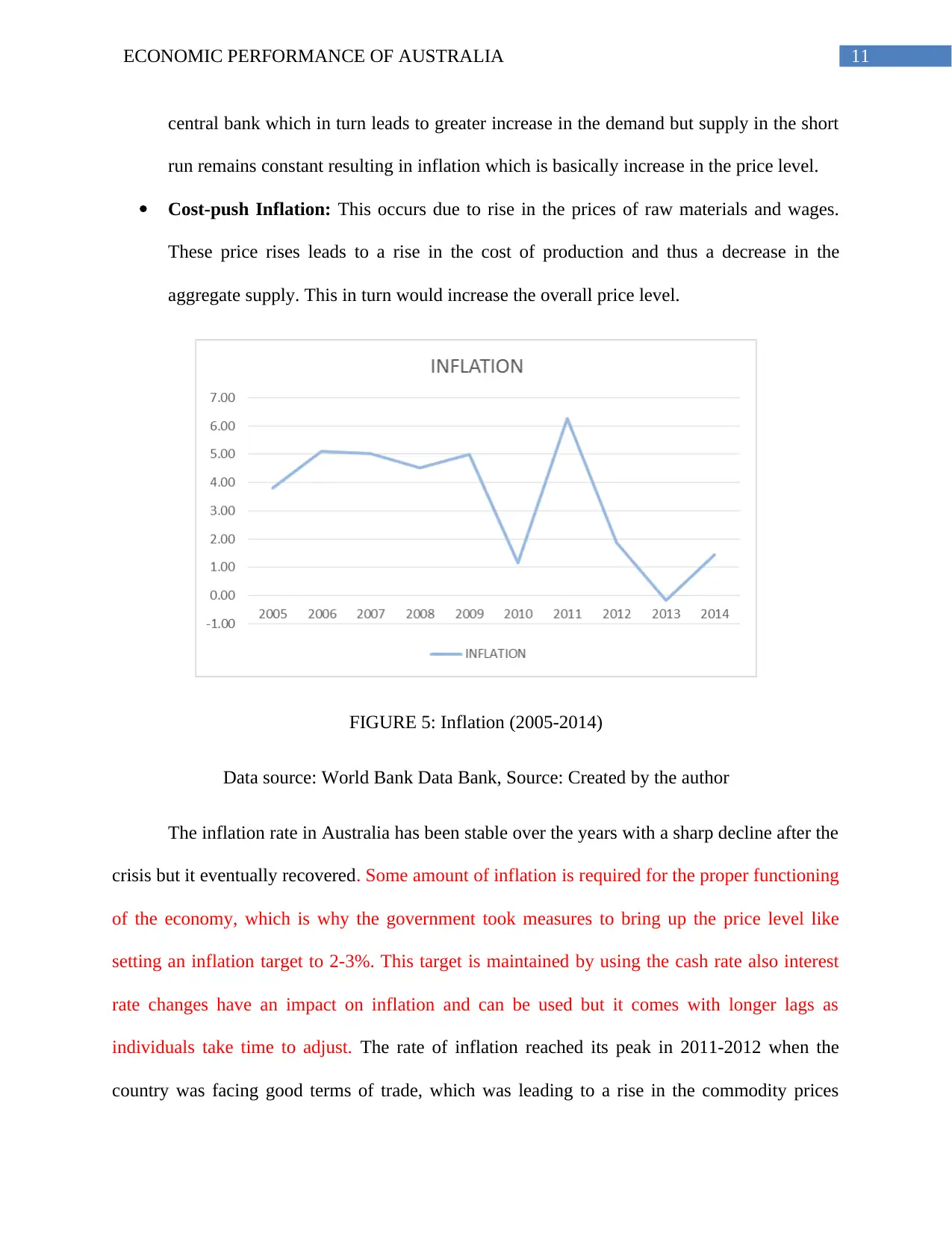
11ECONOMIC PERFORMANCE OF AUSTRALIA
central bank which in turn leads to greater increase in the demand but supply in the short
run remains constant resulting in inflation which is basically increase in the price level.
Cost-push Inflation: This occurs due to rise in the prices of raw materials and wages.
These price rises leads to a rise in the cost of production and thus a decrease in the
aggregate supply. This in turn would increase the overall price level.
FIGURE 5: Inflation (2005-2014)
Data source: World Bank Data Bank, Source: Created by the author
The inflation rate in Australia has been stable over the years with a sharp decline after the
crisis but it eventually recovered. Some amount of inflation is required for the proper functioning
of the economy, which is why the government took measures to bring up the price level like
setting an inflation target to 2-3%. This target is maintained by using the cash rate also interest
rate changes have an impact on inflation and can be used but it comes with longer lags as
individuals take time to adjust. The rate of inflation reached its peak in 2011-2012 when the
country was facing good terms of trade, which was leading to a rise in the commodity prices
central bank which in turn leads to greater increase in the demand but supply in the short
run remains constant resulting in inflation which is basically increase in the price level.
Cost-push Inflation: This occurs due to rise in the prices of raw materials and wages.
These price rises leads to a rise in the cost of production and thus a decrease in the
aggregate supply. This in turn would increase the overall price level.
FIGURE 5: Inflation (2005-2014)
Data source: World Bank Data Bank, Source: Created by the author
The inflation rate in Australia has been stable over the years with a sharp decline after the
crisis but it eventually recovered. Some amount of inflation is required for the proper functioning
of the economy, which is why the government took measures to bring up the price level like
setting an inflation target to 2-3%. This target is maintained by using the cash rate also interest
rate changes have an impact on inflation and can be used but it comes with longer lags as
individuals take time to adjust. The rate of inflation reached its peak in 2011-2012 when the
country was facing good terms of trade, which was leading to a rise in the commodity prices
⊘ This is a preview!⊘
Do you want full access?
Subscribe today to unlock all pages.

Trusted by 1+ million students worldwide
1 out of 15
Related Documents
Your All-in-One AI-Powered Toolkit for Academic Success.
+13062052269
info@desklib.com
Available 24*7 on WhatsApp / Email
![[object Object]](/_next/static/media/star-bottom.7253800d.svg)
Unlock your academic potential
Copyright © 2020–2025 A2Z Services. All Rights Reserved. Developed and managed by ZUCOL.




